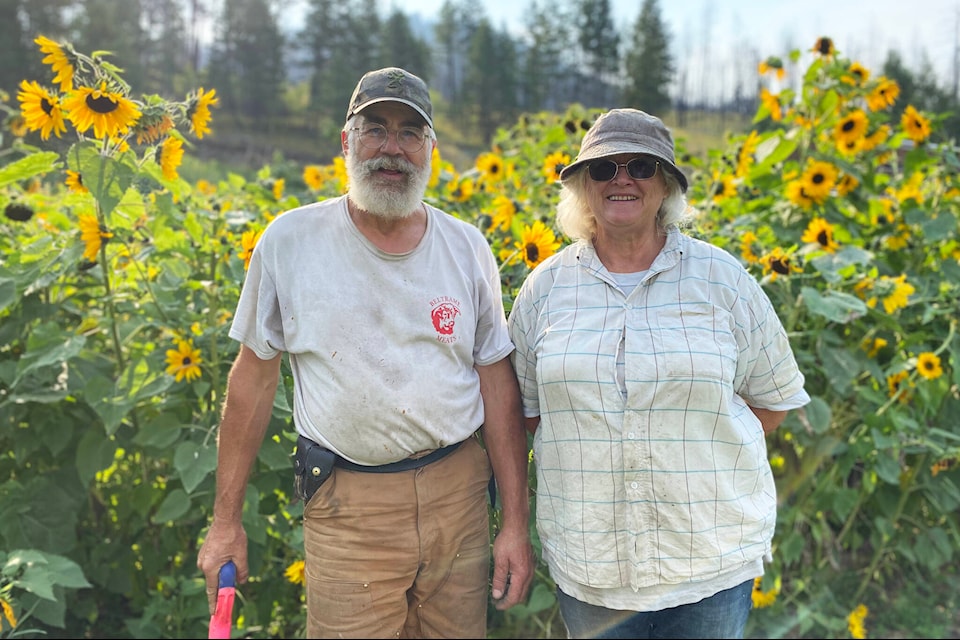Debbie Lloyd’s garden is abounding with sunflowers, all thanks to the goldfinches who spread the sunflower seeds for her.
The property, Whiskey Creek Acres, sits about half an hour outside of Williams Lake near the Rudy Johnson Bridge. Originally from Port Moody, she moved to Williams Lake in 1975, a day before she turned 18. She described the change as a “terrible culture shock,” although now she doesn’t want to go anywhere else.
“I like it here.”
She met her husband, George Beltrame, when he worked as a millwright building the biomass-power plant, and she was there cleaning. They got together and have now been married for 30 years.
Each Friday throughout the summer and into the first week of October, Lloyd heads to the Williams Lake Farmers’ Market with sunflowers, hand-made baskets and produce. She’s been doing so for the last 25 years.
The couple’s 14-acre property is mostly hillside, leaving about three acres around their house and half an acre for their garden. From the garden grow onions, leeks, celery, zucchini, lettuce, garlic, potatoes, carrots, cucumbers, beets, Swiss chard and more.
The garden also contains hundreds of bright sunflowers in varying shades of yellow and orange. While some sunflowers end up at the farmers’ market for $5 a bundle, she leaves the rest for the goldfinches, which happily spread the seeds. She’s able to witness this while sitting in her garden.
“The mom will come in, and there’ll be about five or six little babies, and they’ll all perch there on a flower, and then she’ll feed them.”
After a few weeks, the mom will start ignoring them so the babies learn how to feed themselves, Lloyd noticed.
Her sunflowers bloom “whenever they feel like it,” typically starting in July and lasting until the first frost. People also purchase her sunflowers for weddings, 150 of which were going to a wedding when the Tribune spoke with Lloyd.
In addition to the sunflowers, Lloyd makes baskets from natural materials, which she’s been making for 30 years. When she and her husband got their property, it had no power (although power lines have since gone in). While he worked, she stayed home with the kids, taking them to and from the school bus stop each day.
She grew bored, bought a book and began making baskets.
At first, she’d fill the baskets as Christmas presents with different homemade jams — raspberry, Saskatoon berries, blackberries and blueberries. After about five years, her mom encouraged her to spread her wings.
“My mom said, ‘These are getting pretty big, you should sell them,’” and that’s precisely what she did, first at craft fairs and then later at the farmers’ market after she joined a friend who invited her one year. She’s been there ever since.
Her baskets are made of materials she and her husband collect in August by the river by their house. They pick up all the reeds, bundle them together and dry them out in the greenhouse.
In the fall, Lloyd will take a bundle and begin assembling the baskets. Some are made of scarlet runner bean vines, others from bulrushes. Others are made from pine needles Beltrame collects in Cache Creek.
“I make them in October after the garden is put to bed.”
The handle is carved out of wood, many from the dead junipers left behind after the 2017 wildfires came through their property.
“That was terrible,” Lloyd said of the fires.
The fire crossed the river onto their property, destroying their shop, machine shed, greenhouse, root house and barn. The only things spared were their house, their two horses and their steers, which survived after they left their gate open for the animals to flee.
Beltrame described the energy of the fire like nothing he’d ever seen before, like a tornado tipped on its side, moving horizontally rather than vertically.
It took 11 months before they got power back after putting the power line in. Beltrame then cut down the dead trees, scraping the charcoal off them and piling the logs. He purchased a sawmill in Salmon Arm and, once COVID hit, began rebuilding their shop and greenhouse.
“It was quite a life-changing event,” said Lloyd.
Now, Lloyd takes the bark off the juniper branches and carves them into handles. One basket takes about a day to complete, and she aims to make 20 to 30 baskets each year. She then sells them at different markets throughout the year.
The next time you’re in Williams Lake, stop by the local farmers’ market, where you can find Lloyd’s shop, Whiskey Creek Acres. Look for the sunflowers. You can’t miss them.
